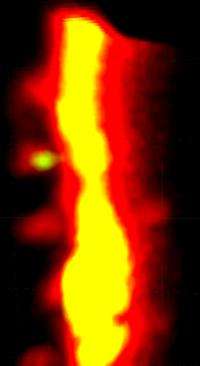Function of a neglected structure in neurons revealed after 50 years

(PhysOrg.com) -- Fifty years after it was originally discovered, scientists at the Friedrich Miescher Institute for Biomedical Research, Switzerland, have elucidated the function of a microscopic network of tubules found in neurons. This structure modulates the strength of connections between two neurons, thereby contributing to our ability to learn and to adapt to new situations.
For neurobiologist Thomas Oertner of the Friedrich Miescher Institute for Biomedical Research, which is part of the Novartis Research Foundation, this was a eureka moment: "After years of intensive research, we've managed to ascribe an important function to a neglected structure in nerve cells."
In the current online issue of the Proceedings of the National Academy of Sciences, Oertner's group describes how the microscopic network of tubules known as the endoplasmic reticulum (ER) modulates the strength of connections between neurons. Neural connections play an important role in our ability to learn new information and constantly adapt to new conditions. In the brain, synaptic connections between neurons are thus continually formed, strengthened or weakened.
In addition, there are connections that remain stable - for example, when we store an important memory for many years. Connections of both types coexist, and their close proximity was one of the first key findings of Thomas Oertner's study: the two types occur side by side on the same neuron and are individually controlled.

Niklaus Holbro, a PhD student in Oertner's group and co-author of the study, also shows that - surprisingly - the presence of ER in the dendritic spines of neurons accounts for the difference between stable and variable synaptic connections. If ER is present, the connections between cells can weaken. When the neuron is stimulated, large amounts of calcium are released from the ER in the spines, triggering functional changes in the synapses. The FMI neurobiologists have thus been able to ascribe an important function to this hitherto mysterious structure 50 years after it was first described by Edward George Gray in 1959.
As the next step, Oertner's team intends to investigate to what extent the ER-dependent process plays a role in patients with fragile X syndrome. This condition is one of the most common inherited cognitive disorders, marked by reduced intelligence, learning difficulties and attention deficits. Explaining the possible biomedical implications of his discovery, Oertner says: "We already know that patients with this syndrome have abnormal dendritic spines. We suspect that the same signaling cascade that is activated in the ER-positive spines could be overstimulated in these patients."
More information: Holbro N et al. (2009) Differential distribution of endoplasmic reticulum controls metabotropic signaling and plasticity at hippocampal synapses. Proceedings of the Natural Academy of Sciences, 18 August 2009, doi: 10.1073/pnas.0905110106
Provided by Friedrich Miescher Institute for Biomedical Research















